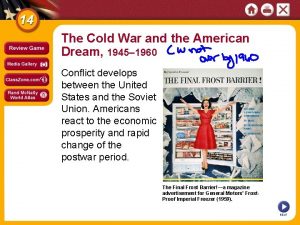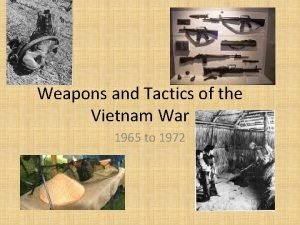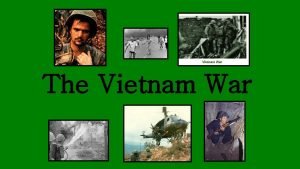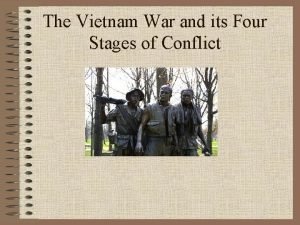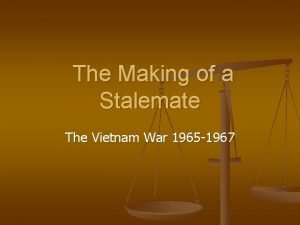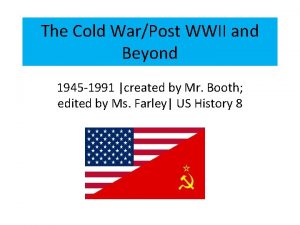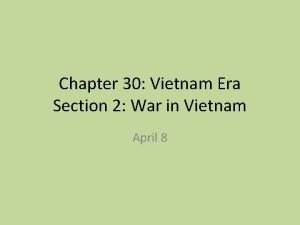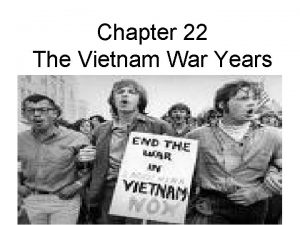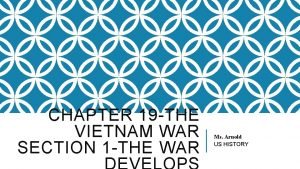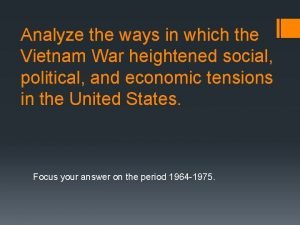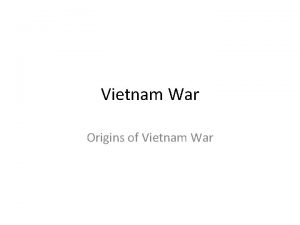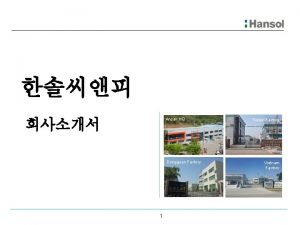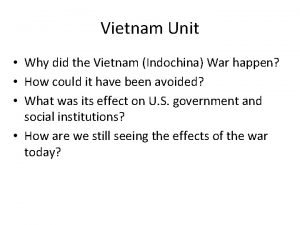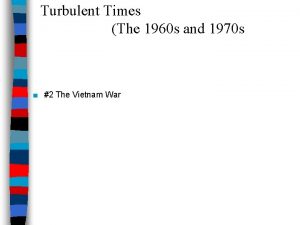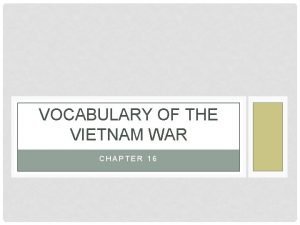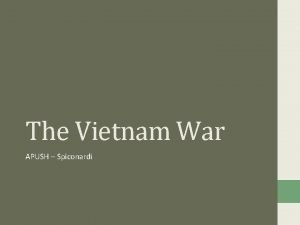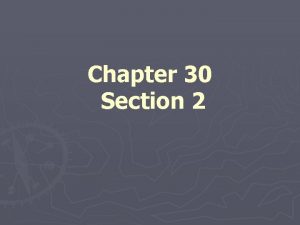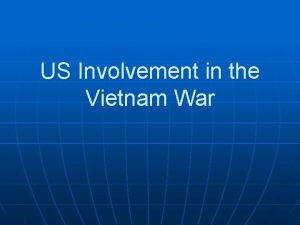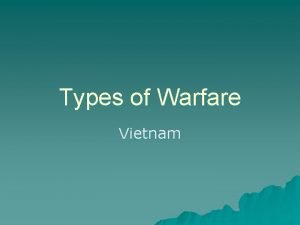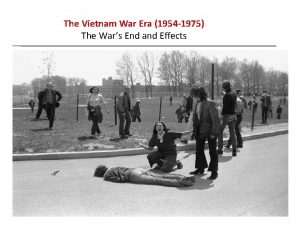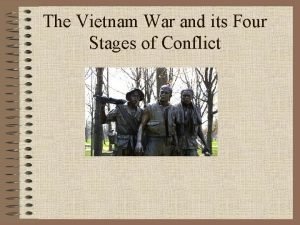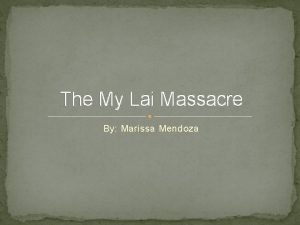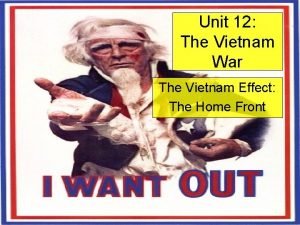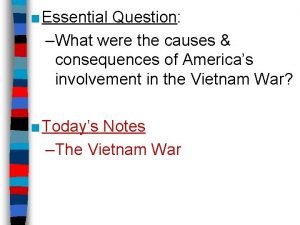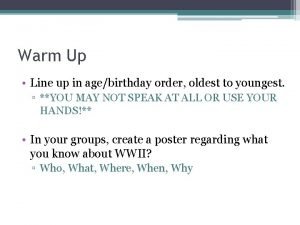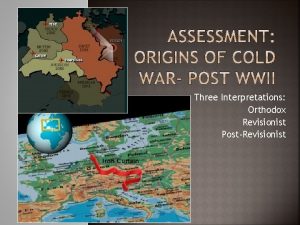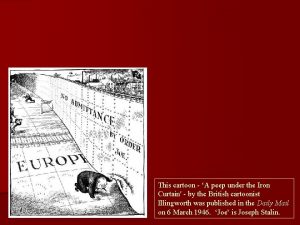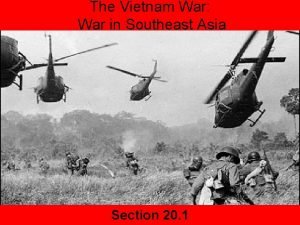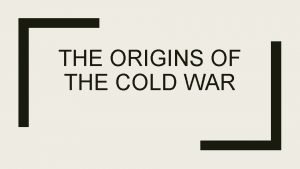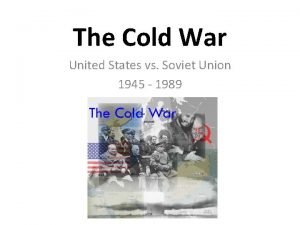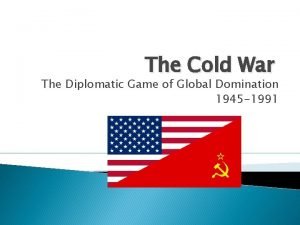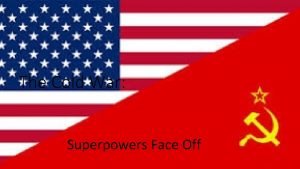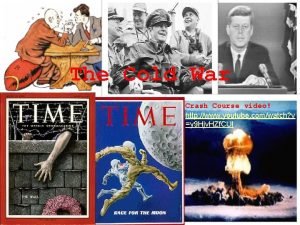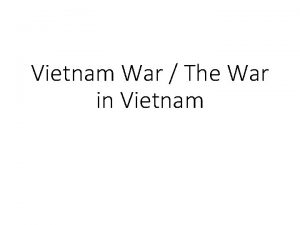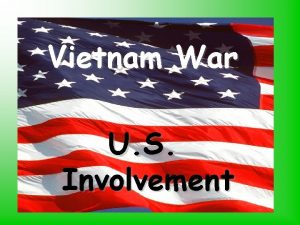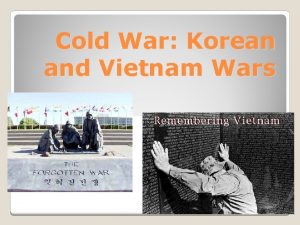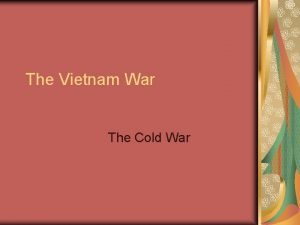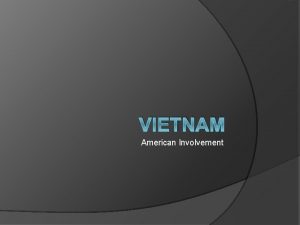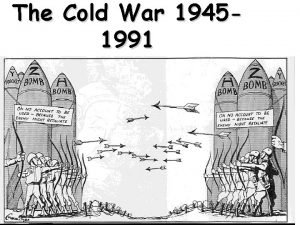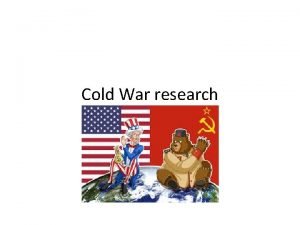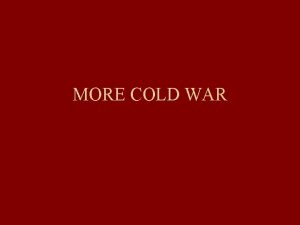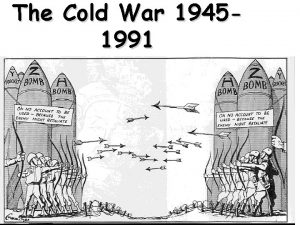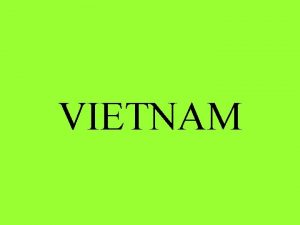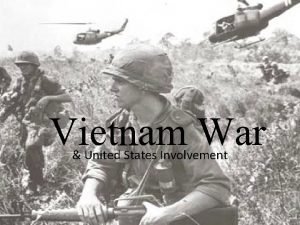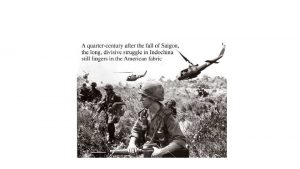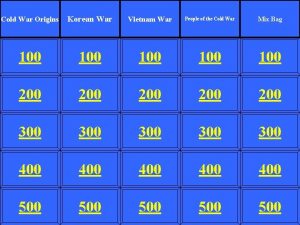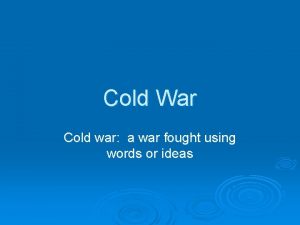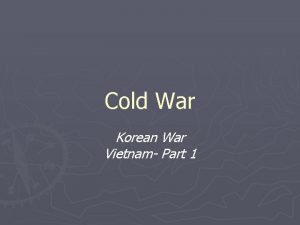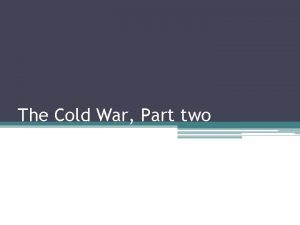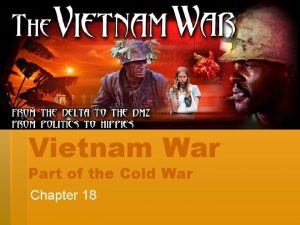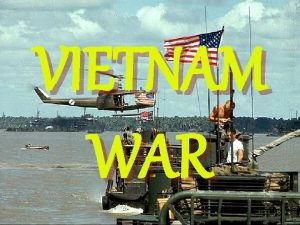Cold War Part 2 Vietnam Vietnam American involvement





































- Slides: 37

Cold War Part 2 Vietnam

Vietnam • American involvement in Vietnam reflected the policy of containment – US provided France with economic and military support to keep control of Vietnam • Ho Chi Minh= communist leader of North Vietnam who wanted to unite all of Vietnam under communist rule • DOMINO THEORY- Eisenhower believed that if one country in SE Asia fell to communism, other would follow- like dominoes • Dien Bien Phu (1954)- N. Vietnamese forces defeated French- Vietnam divided- North-Communist, Southanticommunist


US Involvement in Vietnam • When France left Vietnam, the US continued to provide economic and military support to S. Vietnam to resist the spread of communism • Kennedy sent US military advisers to train S. Vietnamese army

American military build-up • Lyndon B. Johnson (LBJ) agreed with JFK that a communist takeover in S. Vietnam would be a disaster • Tonkin Gulf Resolution (1964): granted LBJ broad military power in Vietnam to escalate the conflict (but no official war declaration) – Led to increased military buildup of operations • the scale of conflict grew larger over the course of the 1960 s • American military forces repeatedly defeated the N. Vietnamese forces in the field, but couldn’t force an end on favorable terms

Escalation • Under the leadership of General Westmoreland, troops conducted search and destroy missions – Kept calling for more and more men – 1965 - draft was implemented Year Troops 1965 184, 000 1966 385, 000 1967 485, 000 1968 538, 000

Who exactly is the enemy? • Vietcong- procommunist South Vietnamese – Farmers by day, guerillas by night – Very patient people willing to accept many casualties – The US grossing underestimated their resolve and resourcefulness – Called “V. C. ” or “Victor Charlie” or “Charlie” • Ho Chi Minh Trail- supply route through Laos and Cambodia along which the Vietcong received weapons and supplies from N. Vietnam

American Troops Had superior weapons Were unprepared for heat, terrain, or guerilla tactics Lacked support of most South Vietnamese Most never saw the enemy but constantly faced the possibility of sudden danger Vietcong Troops Fought as guerillas; avoided head-on clashes Were familiar with terrain; had support of many South Vietnamese Built and hid in elaborate underground tunnels

Escalation • Pleiku (1965): Vietcongs attack US air base. US steps up bombing raids and use land troops for the first time • Operation Rolling Thunder (1965): full scale bombing attacks- obvious escalation of war


American strategy • American strategy was the wear down the enemy by continuing harassment – Napalm was a jellylike substance which, when dropped from planes splattered and burned uncontrollably. – Pilots dropped a herbicide called Agent Orange over the jungles to kill vegetation and expose Vietcong tunnels and hiding places • Caused death, disabilities and birth defects • Another strategy was to keep the Vietcong from winning support from S. Vietnam’s rural population – Green Berets (US Army Special Forces) sent in to win the people over


America’s st 1 Living Room War • Gone is the censorship of WWII • Each night, Americans watched graphic and brutal images of the war • Body counts were reported on the nightly news • Draft numbers were posted in newspapers and on television

Credibility gap • People began to distrust what the Johnson Administration was telling them

The war divides America • Selective Service Act invoked drafting men ages 18 -26 – Conscientious objectors- people opposed fighting on moral or religious grounds – College deferment – Defense industry deferment – Medical deferment • Disproportionate representation of poor people and minorities

Doves People who strongly opposed the war and believed the US should withdraw Hawks People who strongly favored the war and believed the US should provide a greater military presence.

Tet Offensive • January 31, 1968 - 1 st day of the Vietnamese new year (Tet) • Vietcong attacked numerous cities, towns and Americans bases • Americans caught completely by surprise b/c they believed the Vietcong were near defeat – Remember that credibility gap? • Proved to be a turning point in the war – Psychological victory for Vietcong – American opinion began to turn against the war

Reactions to President Johnson • LBJ’s popularity plummeted after the Tet offensive – US media reporting we were losing – LBJ rarely left the White House • In public opinion polls taken at the end of Feb 1968 showed nearly 60% of Americans disapproved of his handling of the war – Eugene Mc. Carthy and Robert Kennedy begin campaigning against him for party nomination • LBJ decides not to run in election of 1968

1968 • Viewed as one of the most turbulent years in modern American history • Tet Offensive • Rise of the counterculture • 4/4 -King assassination (riots and violence that followed) • 6/4 - Bobby Kennedy assassinated

Election of 1968 Democratic Candidate Republican Candidate George Wallace- champion of school segregation and states rights Richard Nixon- Former VP (under Eisenhower) Promised to restore “law and (remember him from Univ of order” Alabama) • What does that mean? What is happening? Herbert Humphrey- VP (under LBJ) • Pull the US out of Vietnam Wins the nomination-people not happy

Nixon and Vietnamization • Nixon wanted to achieve “peace with honor” • Strategy called Vietnamization- gradual withdrawal of American troops as the South Vietnamese army takes over more of the fighting • Wanting to keep American strength visible in Vietnam, he orders secret attacks against the Vietcong in N. Vietnam, Laos and Cambodia

My Lai Massacre 1969 • A platoon entered the small village of My Lai in search of Vietcong • Found no signs of the enemy and the troops rounded up the villagers and shot them • Protests erupted!!

Cambodia • By 1970 it seemed like the war was winding down • April 30, 1970, Nixon announced that US troops had invaded Cambodia to clear out Vietcong supply centers – Had notified Congress – Congress passed the War Powers Act: the president must report to Congress within 24 hours after committing troops to a foreign conflict, or enlarging American combat units in foreign nations • College students burst into protest – Closed down some 1, 200 campuses

Kent State University Shootings • May 4, 1970 Massive student protest in response to US involvement in Cambodia • Led to burning of the ROTC building • National Guard called in and fired into a crowd of students – 67 rounds in 13 seconds – 4 students dead (2 of which were not participating in the protest – 9 students wounded


War comes to and end • October 1972 - Henry Kissinger (Sec of State) announced “Peace is at hand” – US would remove all troops – N. Vietnam could leave troops already in S. Vietnam – N. Vietnam would resume war – No provisions for POWs or MIAs • Last American troop left South Vietnam in March 1973 • 1975 - N. Vietnamese defeated the South

Legacy of War • Veterans were not supported – Called “baby killers”, spit on, assaulted – Many POW/MIA – Returned home to no jobs and substance abuse • Many became homeless • Government passed the 26 th Amendmentvoting age 18 • War Powers Act- President MUST notify congress within 48 hrs of deploying troops – Must withdraw forces within 90 days unless Congressional approval

Price of Vietnam War 58, 000 Americans killed +350, 000 wounded Vietnamese ~1. 5 million killed 2, 583 American POWs/MIAs still UNACCOUNTED for today US morale, self-confidence, trust of government decimated 500, 000 acres of Vietnam sprayed with Agent Orange. Effects may last up to 100 years


Cold War Part 2 Counterculture

Roots of the movement • Beat movement of the 50 s- freedom from materialism • Civil Rights Movement- question traditional boundaries • Vietnam anti-war movement- social and political protest • Generation Gap- lack of understanding between older and younger generations

Hippies • Mostly middle class white kids • Promoted peace, love and freedom – Experimented with new styles, attitudes toward sexual relationships and the recreational use of drugs • Center of the movement was the Haight-Ashbury District of San Francisco

Activism • Free Speech Movement and Students for Democratic Society – Campaigns against the draft, discrimination, dress codes, etc.

Woodstock • August, 1969 - “three days of peace, music, and love” at Yasgur’s 600 acre farm in Woodstock, NY • Pivotal moment in music history


Women’s Rights Movement • Betty Friedan- The Feminine Mystique – Outlined idea of feminism • Equality in jobs, pay, politics, etc. • “Glass ceiling” effect- An invisible but real barrier through which the next stage of advancement can be seen but not reached • National Organization of Women (NOW) – Encouraged women to run for political office • Roe v. Wade- Women have fundamental right to privacy- making abortion legal in the 1 st trimester

Other Movements • United Farm Workers- Cesar Chavez • American Indian Movement- securing land, legal rights and self-government for Native Americans • Environmental Movement- Rachel Carson Silent Spring – Environmental Protection Agency – 4/22/1970 - 1 st Earth Day
 Welcome 1 unit 10 lesson 1
Welcome 1 unit 10 lesson 1 Vietnam war
Vietnam war Sclc and sncc venn diagram
Sclc and sncc venn diagram Fought
Fought American dream cold war
American dream cold war Us weapons vietnam war
Us weapons vietnam war What was the result of the vietnam war
What was the result of the vietnam war Vietnam war stages
Vietnam war stages Did the vietnam war end in a stalemate
Did the vietnam war end in a stalemate Civil war digging deeper webquest answers
Civil war digging deeper webquest answers Space bar
Space bar The vietnam war years chapter 22
The vietnam war years chapter 22 Chapter 19 the vietnam war
Chapter 19 the vietnam war Analyze the ways in which the vietnam war heightened social
Analyze the ways in which the vietnam war heightened social The vietnam war
The vietnam war Vietnam war
Vietnam war Operation rolling thunder cold war
Operation rolling thunder cold war Vietnam war 1960
Vietnam war 1960 Vietnam war vocabulary
Vietnam war vocabulary Vietnam war apush
Vietnam war apush Agent orange and napalm
Agent orange and napalm Vietnam
Vietnam Vietnam war traps
Vietnam war traps Reason for vietnam war
Reason for vietnam war Effects of the vietnam war
Effects of the vietnam war Stages of the vietnam war
Stages of the vietnam war Marissa lai
Marissa lai Pro vietnam war slogans
Pro vietnam war slogans What were the causes and effects of the vietnam war
What were the causes and effects of the vietnam war Cold war timeline
Cold war timeline Postrevisionist
Postrevisionist Iron curtain cartoon analysis
Iron curtain cartoon analysis Operation rolling thunder cold war
Operation rolling thunder cold war The causes of cold war
The causes of cold war Soviet
Soviet Effects of cold war
Effects of cold war Superpowers cold war
Superpowers cold war Cold war crash course
Cold war crash course




